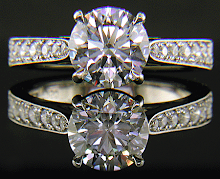And yes, my current client plans to hang this new custom pendant early Christmas morning on their tree for his wife to find !
in the Bijoux Extraordinaire Necklace Gallery.
A jewelry designer's view of fine jewelry, beautiful gemstones and sparkling diamonds

And yes, my current client plans to hang this new custom pendant early Christmas morning on their tree for his wife to find !
Valentine's Day is just around the corner and hopefully Spring soon follows. If we believe the groundhog, Spring should be here about four weeks later!
To help celebrate we have reduced the prices of a number of the estate brooches in the Antique and Estate Jewelry Gallery. These beautiful antique jewels are perfect for any special occasion or season. In the gallery you will find wonderful examples of jewels from the Victorian, Art Nouveau, Edwardian and Art Deco periods.
While visiting the estate gallery, please also visit our collections of fine contemporary jewels and gemstones.
Designing a new ring, pendant or brooch is an exciting experience, a time of anticipation and imagination. One of my favorite steps in the process is comparing and selecting gemstones. Helping a client find the perfect gemstone for a design is almost as much fun as unveiling the finished jewel.
When selecting gemstones for a design several factors should be considered - the most important of which are color, cut and size. To help us discuss each of these factors I have posted above a photo of two radiant-cut sapphires from our inventory.
When evaluating colored gemstones the obvious first consideration is the color. Gemstones come in an amazing spectrum of colors that spans all the hues of the rainbow. Even among blue sapphires there is a great variety in shades ranging from light pastels to intense royal blues and violets. The two sapphires pictured above illustrate this colorful variety. The larger sapphire is a wonderful soft velvety blue while the smaller sapphire is a more intense shade of violet. When working on a project, I will often examine 20 or more gemstones before finding the one with just the right color for the jewel.
Cut is the second factor to consider. The cut of a gemstone should complement and enhance the beauty of a jewel. The two illustrated sapphires are wonderful examples of square radiant cuts. The radiant cut weds the classic step faceting of an emerald cut with the brilliant faceting favored by diamond cutters. The result is a wonderful marriage of elegance and sparkle that goes well with Art Deco-inspired designs and the flowing, geometric forms of Modern jewels.
A ring I recently created, Sapphire Seduction, illustrates the sparkling elegance of a radiant-cut sapphire. In another design, Purple Decodence, I chose a classic emerald-cut sapphire, because the striking geometry of the purple gemstone beautifully complements the platinum setting.
Finally we consider size. First off, bigger is not always better when it comes to fine gemstones. A smaller, beautifully cut gemstone with exceptional color will almost always have a greater impact than a larger mediocre stone. What is important is that the size of the gemstone balances and complements the other elements of the jewel without overwhelming them. Keep Goldilocks in mind - "You don't want a gem that is too large or too small, you want one that is just right for the design!"
We have discussed color, cut and size which leads to the question "How do you evaluate and compare each of these factors as you search for the perfect gemstone?" The truth is there are no quick answers, no easy shortcuts. There is no simple formula that can determine what size of gemstone is best for a given design. Online photographs rarely capture the true beauty of a gem's color - they are subject to the accidents of photography and lighting. And although grading reports are helpful in sorting the clunkers from the candidates, they fall short in discriminating the finer qualities of cut.
The best approach is to bring together a collection of the finest gemstones available from various gem cutters. After examining each of the stones in my gemological lab, I then lay them out side-by-side and carefully examine and compare each stone first hand. Evaluating the gems in person, while working with my client, allows us to select the best gem for the jewel we are creating.

 Some clients desired a more rounded, softer edge dome style ring where as others requested a sharper edged band with a flatter profile for a more geometric approach.
Some clients desired a more rounded, softer edge dome style ring where as others requested a sharper edged band with a flatter profile for a more geometric approach.
